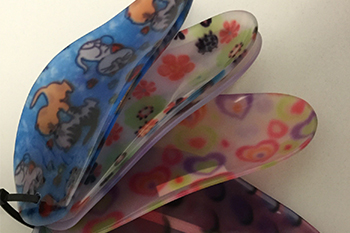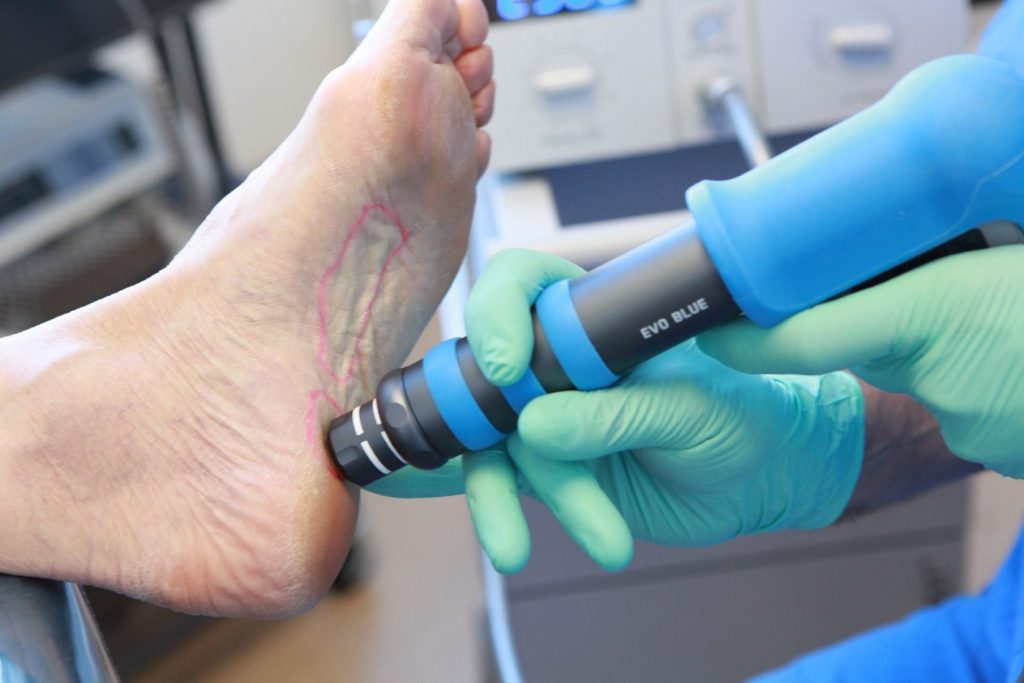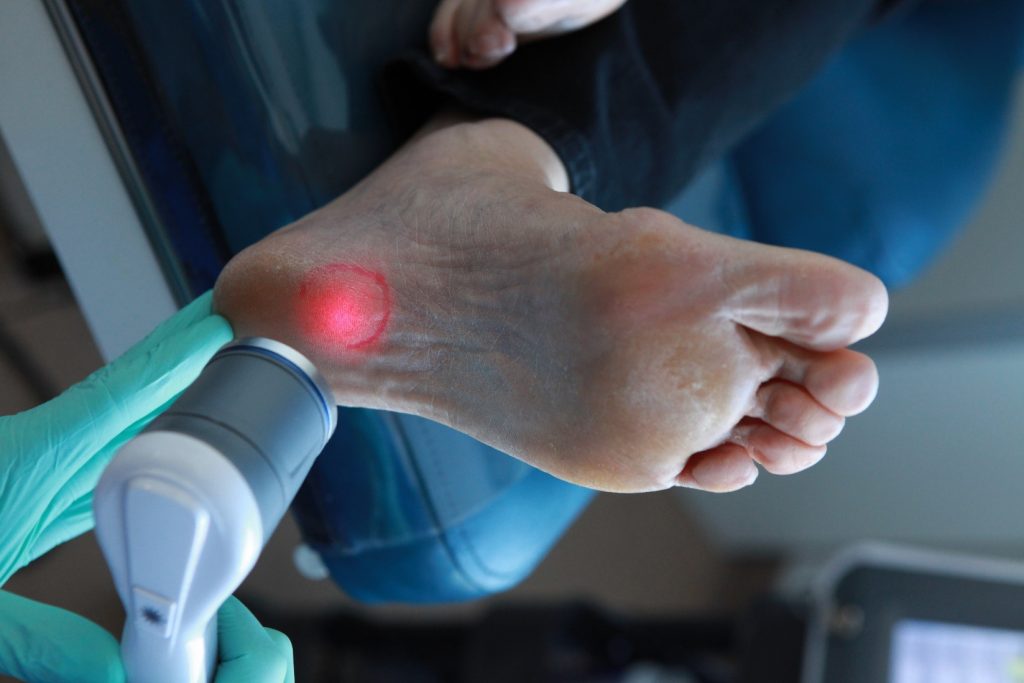SHOCKWAVE THERAPY FOR PAIN

This patient is affected with a long-standing inflammation of the plantar ligament - an intractable, on and off, plantar fasciitis. The ailing foot is now being treated using a shockwave device producing standardized impacts, powerful enough to remove scar tissue, restore elasticity and significantly alleviate the stubborn and limiting heel pain level associated with this condition.
Heel pain, the most common sports injury we treat, can affect the bottom or the back of the heel. If the pain happens at the bottom of your heel bone, it is known as plantar fasciitis. Pain at the back of your heel bone is known as Achilles tendonitis.
Heel pain is a progressive problem, and it may have many concomitant causes. Heel pain is generally the result of faulty foot bio-mechanics that place too much stress onto the heel bone and into the surrounding soft tissues, namely the tibial nerve, plantar ligament and Achilles tendon.
Pain at the inner heel area: The tibial nerve is often overly stretched and compressed as it runs into a very tight tunnel while going down into the inner and bottom aspects of a collapsing flat foot. This is known as a tarsal tunnel syndrome. Best option is to support the foot first though the dispense of orthotics, proper shoes and sometimes foot and ankle braces to stop the nerve elongation and compression due to overpronation. As a second treatment phase, we often laser the affected nerve to restore sufficient cellular energy level to initiate and sustain faster healing and better tissue repair.
Pain at the bottom of the heel: The soft tissue that connects your heel bone to the ball of your foot is called the plantar ligament or plantar fascia. It forms the base of the arch of your foot. It’s like a rubber-band. At rest, the ligament is short and your arch height is optimal. When a person affected with a plantar fasciitis condition stands up, the plantar ligament is then overstretched as the arch of his ailing foot drops down excessively. The collagen fibers inside the fascia begin to be weakened by micro-tears and become more and more inflamed, causing heel pain at its insertion on the heel bone or at some point under the arch. As we age, we also loose elasticity in our ligaments, so over-stretching injuries are more common.
Pain at the back of the heel: The Achilles tendon is the strongest tendon in the body. An overstretching of the Achilles tendon leads to pain and swelling at the insertion of the tendon on the back of the heel bone.
What are the traditional heel pain treatment options?
The classic way to approach heel pain is to prescribe oral (pills) or topical (creams) anti-inflammatory medications or to inject cortisone into the pain area to temporarily numb down the limiting symptoms. Practitioners are sometimes recommending this traditional pathway using concomitant physical therapy in an attempt to further reduce inflammation and pain. Patients who undertake this option can expect 1-3 cortisone injections over a 3-month period along with two weekly physical therapy sessions. They are instructed to restrict their activity level or stay away from any weight-bearing competitive sport activity to allow the pain and inflammation to subside. Athletes with Achilles tendon pain conditions cannot receive cortisone injections because cortisone may cause the Achilles tendon to weaken, tear and rupture.
Do you know by now why the classical heel pain treatment options did not or may not work for you?
-
- The root cause of your heel pain condition is not addressed! Traditional options do not support for your feet nor counteract the repetitive ligament and tendon strains at every single step you take.
- The repair process of the damaged collagen fibers within your inflamed ligament and/or tendon is not promoted! The reverse is true, medication only weakens and taxes your whole body.
If, at first, you had experienced some relief, then why does your heel pain come back to haunt you again?
Recurrence of your heel pain condition is likely to pop up if you did nothing or if you only undertook some traditional heel pain treatment options. Even worse, your ailing heel may deteriorate into an unresponsive chronic condition which is much more difficult to treat at that later stage.
What are the three most effective and holistic heel pain treatment options?
Orthotics

The top seven custom-made orthotic devices most often selected by kids at Ottawa Foot Clinic are shown. We see teens much more likely to wear attractive masterpieces! These thin appliances are real easy to flip from shoes to shoes in no time. Creative personal designs also motivates family and friends - who may be struggling too with some type of heel pain - to seek for same remedy, if this is indicated in their particular foot condition..
Option 1
Custom-made orthotics are first prescribed. These foot supportive medical devices are dispensed to stop the vicious cycle of repetitive ligament and tendon strains imposed to these overloaded structures as the unsupported foot does overpronate or collapse at every step out of the way. In mild and recent heel pain conditions, you may be advised to wait and have your condition reevaluate after a few weeks since you may respond very well to orthotics, even as a stand-alone treatment option. In severe and long-standing heel pain conditions though, it is most often best to immediately initiate options 1, 2 and 3 all at the same time.
Shockwave

This patient is affected with pain and inflammation of the plantar ligament of her left foot, known as a plantar fasciitis condition. The two areas of pain, which have been delimited with a red skin marker, are located within the central body of the plantar ligament (see the rectangular area right under the arch) and at its attachment at the bottom of the heel bone (right where the shockwave device is located and put into action to remove the scar tissue).
Option 2
A series of 3 consecutive weekly sessions of Pain & Regenerative Shockwave Treatments are performed onto the ailing foot areas to remove scar tissues, restore the normal ligament and tendon elasticity and ultimately promote a much better and faster repair of the damaged tissues while noticeably reducing pain level provided custom-made orthotics devices are worn on a full-time basis to prevent further foot collapsing.
Laser

Right after the shockwave session is over, the area of pain is now being treated with laser device to fill the ailing cells with enough energy to initiate and sustain faster and stronger healing and tissue repair.
Option 3
A series of 3 consecutive sessions of Pain Laser Treatments may be performed either as a stand-alone option or right at the end each shockwave session. The goal to drive the necessary energy down into the collagen cells to fabricate new and strong ligament and tendon fibers to reinforce the weakened structures. The lase will also contribute to calm down inflammation, swelling and pain.
Why stand-alone or combined holistic treatment options often lead to better results, especially for active people and athletes?
The holistic pathway using the orthotic, shockwave and laser options – either performed all three at once, in sequence (orthotics first, reevaluate and then add shockwave and laser if need be) or as a single treatment modality (whenever effective enough) works faster and much better in our hands than the traditional options. And, it is designed for Athletes because patients never have to stop or at least resume their activities much more rapidly.
Holistic heel pain treatment involves using the shockwave pain & regenerative therapy and the pain laser therapy options whenever indicated, once collapsing feet are being effectively supported by custom-made orthotic medical devices to be worn most of the time with strong supportive shoes. Unlike the traditional treatments, orthotics addresses the root cause, shockwave removes stiff scar tissues and laser restores depleted cellular energy to promote repair. Quite a synergistic tritherapy for any severe, unresponsive and long-standing condition!
Shockwave pain & regenerative therapy and the pain laser therapy options can help repair damaged tissue without down time and surgery. Shockwave and laser also provides pain relief because it numbs the injured area as it is being administered. They also stimulate the production of endorphins which promote healing. Because shockwave and laser are non-invasive, there are no side effects and no down time associated with the treatment. Half the people who undergo Shockwave or shockwave and laser often achieve a 50-90% pain relief at the end of their very first session. The other half of the patients require 2-3 treatments to provide the stable pain relief they are looking for. Shockwave and laser patients are best not to take any anti-inflammatory medication including cortisone injections, as they may diminish the effectiveness of these treatment options.
Regardless of which pathway or options a patient may elect to undertake to treat their heel pain, custom-made orthotics are most often required to support and stabilize the arch of the foot or to correct any underlying bio-mechanical imbalance that caused the ligament/tendon injury and its resulting heel pain. Achilles tendonitis patients may have heel lifts incorporated into their orthotics to lessen the pull of the tendon at its insertion into the heel bone.
To learn more about your unique foot condition and schedule an appointment with one of our doctor of podiatric medicine, chiropodist and foot specialist, feel free to contact us by phone during regular office hours, make an appointment or submit a question through this site.

